Chow Ang Moh & Fake Ang Moh must die! Next Trade War must BAN Amazon!
https://finance.sina.com.cn/stock/usstock/c/2019-02-06/doc-ihrfqzka3961454.shtml
亚马逊商城假货泛滥 “加拿大鹅”竟来自新加坡
2019年02月06日 13:17 新浪财经综合
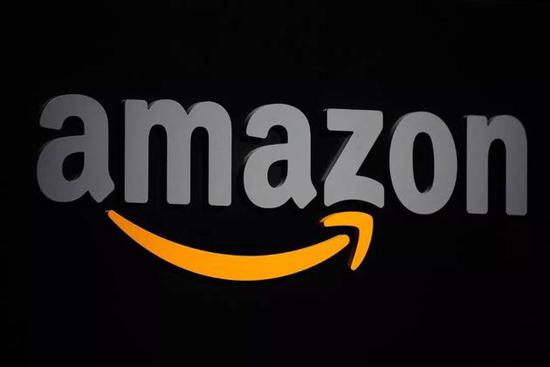 图片来源:视觉中国
图片来源:视觉中国
1月份的最后一天,美国电商巨头亚马逊股价收涨近3%,重回美股市值第一公司的宝座。当天收盘后,亚马逊公布了去年第四季度业绩——营收连续第三个季度打破纪录,营收和盈利均超过市场预期。
可是“美股头牌”仅仅当了一天,在财报后公布后的第二个交易日(2月1日),亚马逊股价大跌近5%。
很多分析师将此归咎于市场对增速放缓的担忧:比如自营电商业务营收增速放缓,比如Prime会员为主的订阅服务营收增速放缓,再如亚马逊在印度布局受挫等。
可是,在2月1日披露的2018年年报中,亚马逊提到了另一大风险:假货。这是亚马逊首次在例行报表中提到假货问题。
财报中首次提到假货
在2018年财报的“风险因素”一栏中,亚马逊提到了很多风险,包括市场竞争、经营压力、投资、库存等等,但最后一项这样写道:公司可能会为商家的欺诈等违法行为负责。

亚马逊在随后的文字描述中提到:
我们无法阻止平台上的商家销售非法、假冒、盗版、或盗窃的商品。这些行为既违反法律,也不符合道德准则,侵犯了他人的权利,也违反了亚马逊的规定。
在亚马逊平台上,时常有消费者投诉买到假货,但在此之前,假冒(counterfeit)、盗版(pirated)等词语从未出现在亚马逊的财报中。为何如今亚马逊专卖将此纳入风险范畴中?
亚马逊在年报中说道,根据公司的纠纷索赔机制,当消费者买到假货,平台将会赔偿。但现在,假货投诉越来越多,导致公司的赔偿成本增加,进而对公司业绩造成负面影响。此外,假货泛滥也损害了公司的形象,导致亚马逊面临一些了民事甚至刑事诉讼。
第三方卖家增多,假货泛滥
亚马逊将假货泛滥归咎于平台上的第三方卖家越来越多。2018年第四季度,第三方卖家的商品销量占比已经超过了全平台的一半,达到52%。
根据Statista统计数据显示,从2013年二季度到2018年三季度,亚马逊平台第三方卖家销量占比从40%增长到了53%。
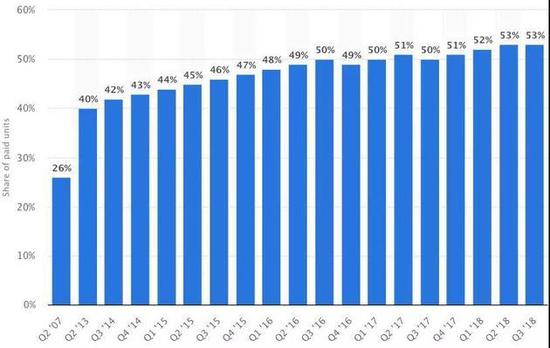 数据来源:Statista
数据来源:Statista
但是,亚马逊并不是没有从中得到好处。通过为商家提供服务,亚马逊的佣金、打包和运输等第三方卖家服务收入年年攀升,2016年为229亿美元,到了2018年则增长到了427亿美元。

当然,这也是亚马逊主动转型的一部分。因为网上商城第三方卖家的销量增速比自营零售销量增速更快,而且毛利率更高,亚马逊不用亲自进货、库存、销售,只需给商家提供服务就能赚钱。
结果,登陆亚马逊的不只有品牌店,还有无数“小商贩”,假货也就从此泛滥开来。
今年1月,美国《大西洋(3.270, 0.12, 3.81%)月刊》的一位作者写了一篇文章,讲诉了自己如何在亚马逊上花925美元买了一件假的“加拿大鹅”:
“当我点击确认下单后,收到一封邮件:我的加拿大鹅正从新加坡发货,将途经中国香港。难道加拿大鹅不是在加拿大生产的?后来我才发现,这个商家的名字不是加拿大鹅,而是一个名叫Greg Adamserft的店家。当时,这个网店只有三条评论,都是五星。几周之后,全都是一星差评。”
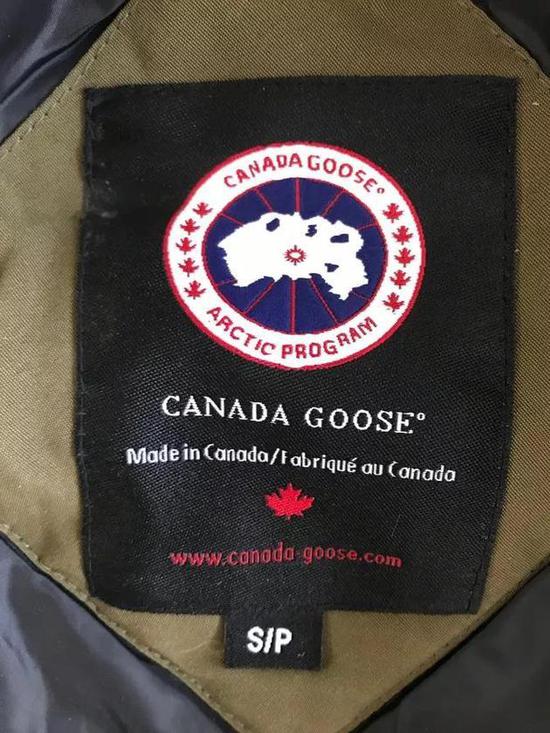 大西洋月刊网站作者Deborah Copaken买到的假“加拿大鹅”
大西洋月刊网站作者Deborah Copaken买到的假“加拿大鹅”
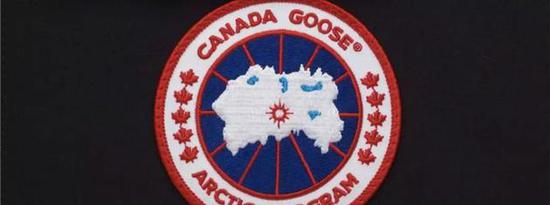 加拿大鹅正品Logo(图片来源:加拿大鹅官网)
加拿大鹅正品Logo(图片来源:加拿大鹅官网)
每经小编(微信号:nbdnews)发现,目前已经有多位消费者投诉说,这家网店卖的加拿大鹅是假货。
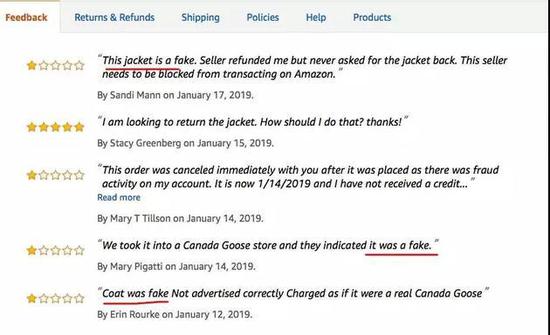
亚马逊打假
第一次在年报中提到假货,并不表示亚马逊之前对这些情况一无所知。“反假货”一直是亚马逊平台的重要条款。

亚马逊反假货规定这样写到:若商家出售或提供假冒产品,亚马逊会立即暂停或终止卖家账户,并销毁该商家在亚马逊物流中心的假货,损失由商家承担。此外,亚马逊也鼓励正品产权所有者举报。
去年12月,亚马逊就以出售盗版教科书为由,处罚了20多家二手书商,暂停了它们的账号。更关键的是,这次处罚不是因为消费者的投诉,而是亚马逊的主动调查。这显示出亚马逊现在对假冒伪劣商品的态度。
亚马逊假货的问题也引起了一些大型零售品牌的注意。美国有一个“服装和鞋类协会”,该协会代表着1000多个品牌的利益,旨在保护各品牌的名誉、知识产权、以及工人和消费者的利益。去年10月,美国服装和鞋类协会建议,美国政府应该将亚马逊平台上的一些第三方网站列入“恶名市场”(Notorious Markets)名单。恶名市场即存在大规模侵犯知识产权行为的市场。
之前几年,服装和鞋类协会都在与亚马逊进行定期对话,去年5月,协会的一些成员与亚马逊的相关团队见了面,讨论了亚马逊对知识产权保护不到位的问题。
虽然“服装和鞋类协会”在建议书上表示“亚马逊有能力、也应该成为打击假冒伪劣产品的领导者”,但让亚马逊恼火的是,这可能让特朗普抓住它的“把柄”。长期以来,特朗普就认为亚马逊存在垄断问题,而且时不时地在社交媒体上“怒喷”亚马逊和创始人贝佐斯,但直到现在,特朗普对亚马逊的威胁还停留在口头阶段。
去年以来,亚马逊也想了一些新办法来保护知识产权,透明项目(Transparency)就是其中之一,该项目通过一种专门设计的条形码来是验证产品真假,先行使用的商家可以免费使用六个月,随后每个条形码将收费1美分至5美分不等。打假,对亚马逊来说,也是一门生意。
来源于每日经济新闻
责任编辑:孟然
Amazon Mall fakes flooded "Canada Goose" actually came from Singapore
February 06, 2019 13:17 Sina Finance Comprehensive
Image Source: Visual China Image Source: Visual China
On the last day of January, US e-commerce giant Amazon shares closed up nearly 3%, returning to the top of the US stock market value. After the close of the day, Amazon announced its fourth-quarter results last year - revenue for the third consecutive quarter broke records, revenue and earnings exceeded market expectations.
However, the "US stock market" was only one day. On the second trading day after the earnings announcement (February 1), Amazon's share price plummeted by nearly 5%.
Many analysts blame the market's concerns about slowing growth: for example, the growth rate of self-operated e-commerce business slows down, such as Prime member-based subscription service revenue growth slows down, and then Amazon's layout in India Frustrated and so on.
However, in the 2018 annual report disclosed on February 1, Amazon mentioned another big risk: fakes. This is the first time Amazon has mentioned a fake issue in a routine report.
The first mention of fakes in the earnings report
In the “risk factors” column of the 2018 financial report, Amazon mentioned a lot of risks, including market competition, business pressure, investment, inventory, etc., but the last one wrote: the company may be illegal for businesses such as fraud Be responsible for.
Amazon mentioned in the following text description:
We can't prevent merchants on the platform from selling illegal, counterfeit, pirated, or stolen goods. These acts violate both the law and the ethical standards, infringe on the rights of others, and violate Amazon's rules.
On the Amazon platform, consumers often complain about buying fakes, but before that, counterfeit, pirated and other words never appeared in Amazon's earnings. Why is Amazon's monopoly now included in the risk category?
Amazon said in the annual report that according to the company's dispute resolution mechanism, when consumers buy fake goods, the platform will compensate. But now, more and more counterfeit complaints have caused the company to increase the cost of compensation, which in turn has a negative impact on the company's performance. In addition, the proliferation of counterfeit goods has also damaged the image of the company, causing Amazon to face some civil and even criminal proceedings.
Third-party sellers increase, fakes flood
Amazon is blaming more and more third-party sellers on the platform for the proliferation of fakes. In the fourth quarter of 2018, third-party sellers accounted for more than half of the total platform sales, reaching 52%.
According to Stastata statistics, from the second quarter of 2013 to the third quarter of 2018, the sales of third-party sellers on the Amazon platform increased from 40% to 53%.
Source: Statista Source: Statista
However, Amazon is not without benefiting from it. By providing services to merchants, Amazon's third-party seller service revenues such as commissions, packaging and transportation have risen year after year, from $22.9 billion in 2016 to $42.7 billion in 2018.
Of course, this is also part of Amazon's proactive transformation. Because the sales growth rate of third-party sellers in online shopping malls is faster than that of self-operated retail sales, and the gross profit margin is higher, Amazon does not need to purchase goods, inventory, and sales in person, and only need to provide services to businesses to make money.
As a result, not only brand stores that landed on Amazon, but also countless “small vendors”, fakes have flooded.
In January of this year, an author of the US Atlantic (3.270, 0.12, 3.81%) monthly magazine wrote an article about how to buy a fake "Canada Goose" for $925 on Amazon:
“When I clicked to confirm the order, I received an email: My Canadian Goose is being shipped from Singapore and will pass through Hong Kong, China. Isn’t the Canadian Goose produced in Canada? Later I discovered that the name of this business is not Canada. Goose, but a store named Greg Adamserft. At the time, the online store had only three comments, all five stars. After a few weeks, all were a star rating."
The fake "Canada Goose" bought by Deborah Copaken, the fake "Canada Goose" Atlantic Monthly website, purchased by Deborah Copaken, the website of the Atlantic Monthly website.
Canada Goose Genuine Logo (Source: Canada Goose Official Website) Canada Goose Genuine Logo (Source: Canada Goose Official Website)
Every Xiaobian (micro-signal: nbdnews) found that many consumers have complained that the Canadian goose sold in this online store is a fake.
Amazon counterfeiting
The first mention of counterfeit goods in the annual report does not mean that Amazon had no knowledge of these situations before. "Anti-counterfeit" has always been an important part of the Amazon platform.
The Amazon anti-counterfeiting rule states that if a merchant sells or provides a counterfeit product, Amazon will immediately suspend or terminate the seller's account and destroy the merchant's counterfeit goods at the Amazon Logistics Center. The loss is borne by the merchant. In addition, Amazon also encourages genuine property owners to report.
In December last year, Amazon punished more than 20 second-hand booksellers and suspended their accounts on the grounds of selling pirated textbooks. More critically, this punishment is not due to consumer complaints, but to Amazon's active investigation. This shows Amazon's attitude towards fake and shoddy goods.
The problem of Amazon fakes has also caught the attention of some large retail brands. There is a “Clothing and Footwear Association” in the United States, which represents the interests of more than 1,000 brands and aims to protect the reputation of each brand, intellectual property, and the interests of workers and consumers. Last October, the American Apparel and Footwear Association recommended that the US government should include some third-party websites on the Amazon platform in the "Notorious Markets" list. In the notorious market, there is a market for massive violations of intellectual property rights.
In the past few years, the clothing and footwear associations have had regular dialogues with Amazon. In May last year, some members of the association met with relevant Amazon teams to discuss Amazon’s lack of intellectual property protection.
Although the “Clothing and Footwear Association” stated in the proposal that “Amazon has the ability and should be the leader in combating counterfeit and shoddy products”, what annoys Amazon is that this may allow Trump to seize its “handle”. . For a long time, Trump believes that Amazon has a monopoly problem, and from time to time on the social media, "angry" Amazon and founder Bezos, but until now, Trump's threat to Amazon is still in the verbal stage.
Since last year, Amazon has also thought of some new ways to protect intellectual property rights. Transparency is one of them. The project uses a specially designed barcode to verify the authenticity of the product. The first-time merchant can use six free of charge. Months, then each barcode will cost between 1 cent and 5 cents. Anti-counterfeiting is also a business for Amazon.
From the daily economic news
Editor in charge: Meng Ran
https://finance.sina.com.cn/stock/usstock/c/2019-02-06/doc-ihrfqzka3961454.shtml
亚马逊商城假货泛滥 “加拿大鹅”竟来自新加坡
2019年02月06日 13:17 新浪财经综合

1月份的最后一天,美国电商巨头亚马逊股价收涨近3%,重回美股市值第一公司的宝座。当天收盘后,亚马逊公布了去年第四季度业绩——营收连续第三个季度打破纪录,营收和盈利均超过市场预期。
可是“美股头牌”仅仅当了一天,在财报后公布后的第二个交易日(2月1日),亚马逊股价大跌近5%。
很多分析师将此归咎于市场对增速放缓的担忧:比如自营电商业务营收增速放缓,比如Prime会员为主的订阅服务营收增速放缓,再如亚马逊在印度布局受挫等。
可是,在2月1日披露的2018年年报中,亚马逊提到了另一大风险:假货。这是亚马逊首次在例行报表中提到假货问题。
财报中首次提到假货
在2018年财报的“风险因素”一栏中,亚马逊提到了很多风险,包括市场竞争、经营压力、投资、库存等等,但最后一项这样写道:公司可能会为商家的欺诈等违法行为负责。

亚马逊在随后的文字描述中提到:
我们无法阻止平台上的商家销售非法、假冒、盗版、或盗窃的商品。这些行为既违反法律,也不符合道德准则,侵犯了他人的权利,也违反了亚马逊的规定。
在亚马逊平台上,时常有消费者投诉买到假货,但在此之前,假冒(counterfeit)、盗版(pirated)等词语从未出现在亚马逊的财报中。为何如今亚马逊专卖将此纳入风险范畴中?
亚马逊在年报中说道,根据公司的纠纷索赔机制,当消费者买到假货,平台将会赔偿。但现在,假货投诉越来越多,导致公司的赔偿成本增加,进而对公司业绩造成负面影响。此外,假货泛滥也损害了公司的形象,导致亚马逊面临一些了民事甚至刑事诉讼。
第三方卖家增多,假货泛滥
亚马逊将假货泛滥归咎于平台上的第三方卖家越来越多。2018年第四季度,第三方卖家的商品销量占比已经超过了全平台的一半,达到52%。
根据Statista统计数据显示,从2013年二季度到2018年三季度,亚马逊平台第三方卖家销量占比从40%增长到了53%。

但是,亚马逊并不是没有从中得到好处。通过为商家提供服务,亚马逊的佣金、打包和运输等第三方卖家服务收入年年攀升,2016年为229亿美元,到了2018年则增长到了427亿美元。

当然,这也是亚马逊主动转型的一部分。因为网上商城第三方卖家的销量增速比自营零售销量增速更快,而且毛利率更高,亚马逊不用亲自进货、库存、销售,只需给商家提供服务就能赚钱。
结果,登陆亚马逊的不只有品牌店,还有无数“小商贩”,假货也就从此泛滥开来。
今年1月,美国《大西洋(3.270, 0.12, 3.81%)月刊》的一位作者写了一篇文章,讲诉了自己如何在亚马逊上花925美元买了一件假的“加拿大鹅”:
“当我点击确认下单后,收到一封邮件:我的加拿大鹅正从新加坡发货,将途经中国香港。难道加拿大鹅不是在加拿大生产的?后来我才发现,这个商家的名字不是加拿大鹅,而是一个名叫Greg Adamserft的店家。当时,这个网店只有三条评论,都是五星。几周之后,全都是一星差评。”


每经小编(微信号:nbdnews)发现,目前已经有多位消费者投诉说,这家网店卖的加拿大鹅是假货。

亚马逊打假
第一次在年报中提到假货,并不表示亚马逊之前对这些情况一无所知。“反假货”一直是亚马逊平台的重要条款。

亚马逊反假货规定这样写到:若商家出售或提供假冒产品,亚马逊会立即暂停或终止卖家账户,并销毁该商家在亚马逊物流中心的假货,损失由商家承担。此外,亚马逊也鼓励正品产权所有者举报。
去年12月,亚马逊就以出售盗版教科书为由,处罚了20多家二手书商,暂停了它们的账号。更关键的是,这次处罚不是因为消费者的投诉,而是亚马逊的主动调查。这显示出亚马逊现在对假冒伪劣商品的态度。
亚马逊假货的问题也引起了一些大型零售品牌的注意。美国有一个“服装和鞋类协会”,该协会代表着1000多个品牌的利益,旨在保护各品牌的名誉、知识产权、以及工人和消费者的利益。去年10月,美国服装和鞋类协会建议,美国政府应该将亚马逊平台上的一些第三方网站列入“恶名市场”(Notorious Markets)名单。恶名市场即存在大规模侵犯知识产权行为的市场。
之前几年,服装和鞋类协会都在与亚马逊进行定期对话,去年5月,协会的一些成员与亚马逊的相关团队见了面,讨论了亚马逊对知识产权保护不到位的问题。
虽然“服装和鞋类协会”在建议书上表示“亚马逊有能力、也应该成为打击假冒伪劣产品的领导者”,但让亚马逊恼火的是,这可能让特朗普抓住它的“把柄”。长期以来,特朗普就认为亚马逊存在垄断问题,而且时不时地在社交媒体上“怒喷”亚马逊和创始人贝佐斯,但直到现在,特朗普对亚马逊的威胁还停留在口头阶段。
去年以来,亚马逊也想了一些新办法来保护知识产权,透明项目(Transparency)就是其中之一,该项目通过一种专门设计的条形码来是验证产品真假,先行使用的商家可以免费使用六个月,随后每个条形码将收费1美分至5美分不等。打假,对亚马逊来说,也是一门生意。
来源于每日经济新闻
责任编辑:孟然
Amazon Mall fakes flooded "Canada Goose" actually came from Singapore
February 06, 2019 13:17 Sina Finance Comprehensive
Image Source: Visual China Image Source: Visual China
On the last day of January, US e-commerce giant Amazon shares closed up nearly 3%, returning to the top of the US stock market value. After the close of the day, Amazon announced its fourth-quarter results last year - revenue for the third consecutive quarter broke records, revenue and earnings exceeded market expectations.
However, the "US stock market" was only one day. On the second trading day after the earnings announcement (February 1), Amazon's share price plummeted by nearly 5%.
Many analysts blame the market's concerns about slowing growth: for example, the growth rate of self-operated e-commerce business slows down, such as Prime member-based subscription service revenue growth slows down, and then Amazon's layout in India Frustrated and so on.
However, in the 2018 annual report disclosed on February 1, Amazon mentioned another big risk: fakes. This is the first time Amazon has mentioned a fake issue in a routine report.
The first mention of fakes in the earnings report
In the “risk factors” column of the 2018 financial report, Amazon mentioned a lot of risks, including market competition, business pressure, investment, inventory, etc., but the last one wrote: the company may be illegal for businesses such as fraud Be responsible for.
Amazon mentioned in the following text description:
We can't prevent merchants on the platform from selling illegal, counterfeit, pirated, or stolen goods. These acts violate both the law and the ethical standards, infringe on the rights of others, and violate Amazon's rules.
On the Amazon platform, consumers often complain about buying fakes, but before that, counterfeit, pirated and other words never appeared in Amazon's earnings. Why is Amazon's monopoly now included in the risk category?
Amazon said in the annual report that according to the company's dispute resolution mechanism, when consumers buy fake goods, the platform will compensate. But now, more and more counterfeit complaints have caused the company to increase the cost of compensation, which in turn has a negative impact on the company's performance. In addition, the proliferation of counterfeit goods has also damaged the image of the company, causing Amazon to face some civil and even criminal proceedings.
Third-party sellers increase, fakes flood
Amazon is blaming more and more third-party sellers on the platform for the proliferation of fakes. In the fourth quarter of 2018, third-party sellers accounted for more than half of the total platform sales, reaching 52%.
According to Stastata statistics, from the second quarter of 2013 to the third quarter of 2018, the sales of third-party sellers on the Amazon platform increased from 40% to 53%.
Source: Statista Source: Statista
However, Amazon is not without benefiting from it. By providing services to merchants, Amazon's third-party seller service revenues such as commissions, packaging and transportation have risen year after year, from $22.9 billion in 2016 to $42.7 billion in 2018.
Of course, this is also part of Amazon's proactive transformation. Because the sales growth rate of third-party sellers in online shopping malls is faster than that of self-operated retail sales, and the gross profit margin is higher, Amazon does not need to purchase goods, inventory, and sales in person, and only need to provide services to businesses to make money.
As a result, not only brand stores that landed on Amazon, but also countless “small vendors”, fakes have flooded.
In January of this year, an author of the US Atlantic (3.270, 0.12, 3.81%) monthly magazine wrote an article about how to buy a fake "Canada Goose" for $925 on Amazon:
“When I clicked to confirm the order, I received an email: My Canadian Goose is being shipped from Singapore and will pass through Hong Kong, China. Isn’t the Canadian Goose produced in Canada? Later I discovered that the name of this business is not Canada. Goose, but a store named Greg Adamserft. At the time, the online store had only three comments, all five stars. After a few weeks, all were a star rating."
The fake "Canada Goose" bought by Deborah Copaken, the fake "Canada Goose" Atlantic Monthly website, purchased by Deborah Copaken, the website of the Atlantic Monthly website.
Canada Goose Genuine Logo (Source: Canada Goose Official Website) Canada Goose Genuine Logo (Source: Canada Goose Official Website)
Every Xiaobian (micro-signal: nbdnews) found that many consumers have complained that the Canadian goose sold in this online store is a fake.
Amazon counterfeiting
The first mention of counterfeit goods in the annual report does not mean that Amazon had no knowledge of these situations before. "Anti-counterfeit" has always been an important part of the Amazon platform.
The Amazon anti-counterfeiting rule states that if a merchant sells or provides a counterfeit product, Amazon will immediately suspend or terminate the seller's account and destroy the merchant's counterfeit goods at the Amazon Logistics Center. The loss is borne by the merchant. In addition, Amazon also encourages genuine property owners to report.
In December last year, Amazon punished more than 20 second-hand booksellers and suspended their accounts on the grounds of selling pirated textbooks. More critically, this punishment is not due to consumer complaints, but to Amazon's active investigation. This shows Amazon's attitude towards fake and shoddy goods.
The problem of Amazon fakes has also caught the attention of some large retail brands. There is a “Clothing and Footwear Association” in the United States, which represents the interests of more than 1,000 brands and aims to protect the reputation of each brand, intellectual property, and the interests of workers and consumers. Last October, the American Apparel and Footwear Association recommended that the US government should include some third-party websites on the Amazon platform in the "Notorious Markets" list. In the notorious market, there is a market for massive violations of intellectual property rights.
In the past few years, the clothing and footwear associations have had regular dialogues with Amazon. In May last year, some members of the association met with relevant Amazon teams to discuss Amazon’s lack of intellectual property protection.
Although the “Clothing and Footwear Association” stated in the proposal that “Amazon has the ability and should be the leader in combating counterfeit and shoddy products”, what annoys Amazon is that this may allow Trump to seize its “handle”. . For a long time, Trump believes that Amazon has a monopoly problem, and from time to time on the social media, "angry" Amazon and founder Bezos, but until now, Trump's threat to Amazon is still in the verbal stage.
Since last year, Amazon has also thought of some new ways to protect intellectual property rights. Transparency is one of them. The project uses a specially designed barcode to verify the authenticity of the product. The first-time merchant can use six free of charge. Months, then each barcode will cost between 1 cent and 5 cents. Anti-counterfeiting is also a business for Amazon.
From the daily economic news
Editor in charge: Meng Ran
